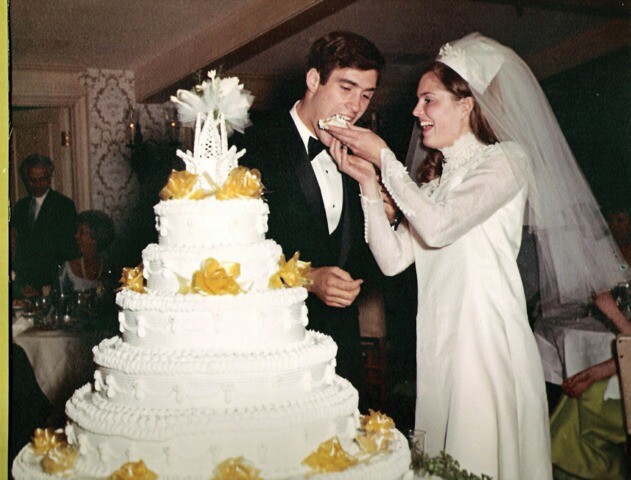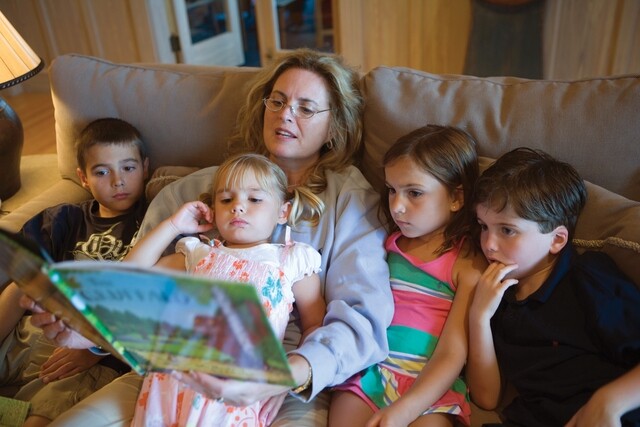You wouldn’t know it by looking at her today, but Ann Romney was once 100 percent tomboy.
“When I was a little girl, I was out catching snakes, catching frogs. I would go by myself with my fishing rod to the lake,” she recalls.
So how did this independent, rough-and-tumble girl become the elegant and articulate public figure she is today, all while keeping her marriage strong, raising five successful sons, and serving as a loving grandmother to nearly two dozen grandchildren? It had a lot to do with finding the gospel.
Ann was born in Detroit, Michigan, on April 16, 1949, to Edward and Lois Davies. One of three children, she grew up in a home where organized religion was not practiced, yet she searched for answers.
“I didn’t have a lot of religious direction from my family, but I was curious about religion,” she recalls. “When I met Mitt, it was just one of those innocent questions when I asked, ‘Oh, what do Mormons believe?’ He began explaining the Articles of Faith. We were just two teenagers chatting, but I loved the principles I was hearing.”
Love and Marriage
Mitt and Ann became high school sweethearts. He confesses he was tempted not to go on his mission so he could be with Ann.
“I didn’t want to be anywhere else but with her,” he recalls. “And so, at the senior prom, as we danced a little bit, we went outside of the school and I turned to her and said, ‘Ann, would you marry me?’ And she said ‘yes.’”
With an unofficial engagement and Ann’s encouragement, Mitt left for his mission in France. His father, who was serving as governor of Michigan and running for president
at the time, continued to help Ann learn more about the Church. He spoke with her parents and got permission to introduce her to the missionaries. At age 18, Ann decided to be baptized, and Mitt’s father did the honors. (Soon her younger brother Jim also joined the Church, and they were eventually followed by Ann’s older brother Rod. Many years later, her mother was also baptized, shortly before she passed away.)
When Mitt returned from his mission, Ann was there at the airport with his family to welcome him. On the car ride home, Mitt proposed once more, and Ann accepted.
They were married in the Salt Lake Temple three months later.

Through the good times and the bad, their love has endured.
“When things aren’t going well, that’s when you realize how wonderful it is to have a real life partner who is truly 100 percent there for you—someone who will support you and love you and cherish you,” Ann says. “That’s what Mitt and I have, and I feel
really fortunate that the difficult life situations that Mitt and I have gone through have made us grow stronger together and care more for each other.”
“Ann’s love for me, of course, is the greatest source of joy I could possibly have,” says Mitt. “The boys recognize that she is my best counselor; she’s the best source of wisdom, the best source of perspective and insight in my life.”
“My dad is completely smitten with her,” adds Tagg, the oldest of Mitt and Ann’s five sons. “The biggest sin we could commit as kids was to talk back to my mother.”
Seasons of Motherhood
More than anything else, people want to know how Ann raised a family of five rambunctious boys to become such good sons, husbands, and fathers.
“I’m convinced that a huge part of who they are came with them from birth. Even when they were babies, I knew they were unique individuals,” she explains. “And, of course, I give a huge share of the credit for what my boys have become to our faith. It set boundaries, gave them confidence to walk in their own paths, and taught them to live for things greater than themselves.”
But as parents with young children know, it can be a challenge to get everyone to church, so Ann got creative. “When my third baby arrived, I took preparations for getting to church to an extreme,” she recalls. “On Saturday night, I dressed the boys for church and put them fully clothed in their beds. Sunday morning, presto, they were in church clothes. Wrinkled, yes, but we got to church on time.”
Although Ann loved being a stay-at-home mom and insisted on doing everything herself, she acknowledges that there were days when her sons pushed her to her limit. “As a young fulltime mom, there were moments when I was at my wit’s end. More than once, I slammed the door, got in the car, and drove away. Then I’d drive
a block, park in a spot where I could still see the house, cry some, and recharge.”
And even though Mitt was often traveling for business, he still provided tremendous emotional support. “When Mitt would call home and hear the exasperation in my voice, he would remind me that the work I was doing inside our home was far more important than whatever he was doing at the time. His work was temporary, but my work would last forever.”
Ann says she always had teaching moments for her boys in the back of her mind—how she wanted them to behave, what she wanted them to care about. “They weren’t always very nice to each other—it was a real frustration for me. Yet, I see them as adults, and they are nice now! It’s just a reminder to young moms not to give up! Keep reminding yourself that you’re teaching your children principles and life lessons. Even though they may not be doing what you want at the moment, you just have to persevere. It takes a long time to raise a child, and the rewards aren’t always there until many years later.”
As a grandmother, Ann now cherishes quality time with her grandchildren, as well as the opportunity to watch her sons raise children of their own. “I kind of enjoy it when my grandchildren misbehave,” she laughs. “It’s interesting to see how well my
children are handling it and how supportive they are of their wives. I just love it.”

The Health Crisis
For Ann, raising five active boys was challenging, but she always seemed to find the energy she needed—until suddenly, in 1997, she began losing her balance and having trouble walking up and down stairs. She began having difficulty swallowing, needing more sleep than usual, and feeling nauseated. At the urging of her family, Ann went to see a neurologist.
At the appointment, Mitt was crushed as he watched his beloved wife fail test after test. Finally, after an MRI, Ann was diagnosed with relapsing-remitting multiple sclerosis. “When [the doctor] left the room, I broke down. Mitt cried too. He would’ve
much rather have received the diagnosis than watch me receive it,” Ann recalls.
“[MS] has left me with a heart that’s more open and compassionate, and it deeply affects how I see others,” she says. “It has been a very good teacher. It’s taught me that there are so many others who are struggling in this life. It gives you a different
perspective—the ability to see through a different lens, to be a little kinder, a little more appreciative of how difficult life can be for some people.”
Ann describes her diagnosis not as a challenge in her marriage but as a strengthening factor. “It was a moment for me to reflect on how blessed I was that I had someone who cared for me so deeply. It was a huge relief for me that when I felt like I wasn’t even going to be able to make dinner anymore or go to the grocery store anymore or do any of those things, Mitt looked at me and said, ‘That’s not why I love you. I just love you.’ He allowed me to be sick, and that’s what allowed me to start to heal.”
The Race for the White House
Ann served as First Lady of Massachusetts from 2003–2007 after Mitt was elected as
the state’s 70th governor. But after serving one term, Mitt decided not to seek reelection. By this time, his sights were set on a loftier goal: the White House.
The decision to run for president in 2008 and 2012 would thrust the Romneys
further into the spotlight, and they endured intense scrutiny by the media and the public at large—especially because of their LDS faith. But whenever the Romneys
were criticized for their religion, Ann’s philosophy was, “Let your light so shine.”
“I didn’t want to have to defend doctrine, and I never did. I think over time, people
had an opportunity to see how we really lived our lives, and that’s a reflection of who we are. Over time, people got to see that Mitt and I had a strong marriage, that we were a loving couple, that we had responsible, wonderful sons. Our faith is a big part of that life.”

But their religion wasn’t the only thing that would come under fire: Ann was also criticized for choosing to be a stay-at-home mom who “never worked a day in her life,” as one Democratic strategist stated on CNN. Ann responded, “She should have come to my house when those five boys were causing so much trouble.”
Ann explains, “Women are always being judged by others for the choices in their lives. The most important thing we can remember is that we can never understand where an individual is coming from. There are very difficult choices that women have
to make in this world right now. For me, I made the choice to stay at home, and I’m very happy that I made that choice. We have to be understanding and appreciative of one another and not be so judgmental.”
Despite the grueling campaign and extreme pressures, Ann describes the 2012 presidential election as one of the most amazing experiences of her life. “I wish everyone would have an opportunity to see this country the way Mitt and I did,” she says. “It’s an extraordinary, beautiful place with extraordinary people. There isn’t one specific event or one moment that stands out—it was just the people that we grew to love, those who were there for us. We were humbled by the experience and so appreciative of those who tried to get us elected.”
The Heart of the Home
While public service was a fulfilling aspect of Ann’s life, nothing could ever be more important to her than being a wife, mother, and grandmother. “For Mitt and me, the greatest blessing in our lives is our family,” she says.
One way that Ann keeps her family close is by establishing traditions with her children and grandchildren—many of which include plenty of delicious food. “Traditions, especially those that involve cooking, can spark conversations about family history and create new memories,” Ann says. “They are the glue that binds a family together. For instance, when I make my grandmother’s piecrust, it brings back so many wonderful memories of what it was like working with her and just getting my hands dirty in the kitchen. Now I’m doing the same thing with my grandchildren,
and I can tell them the stories of their great grandmother. Someday they’ll be doing the same thing with their children and grandchildren.”
She adds, “Traditions are important, but it’s also important to know that traditions don’t happen without a lot of work and preparation. You have to recognize that once you make all this effort, you’re not going to be appreciated. There are going to be children misbehaving, and it’s never a perfect setting. You just have to set the table. When you invite people to that table is when you share experiences, you share life, you share love, and you start to share stories. That’s the fabric of life that brings us so much joy.”
----------------
Read more about the Romneys' favorite traditions and recipes in Ann's New York Times bestselling book, The Romney Family Table, available at Deseret Book.

